“We need another and a wiser and perhaps a more mystical concept of animals. Remote from universal nature, and living by complicated artifice, man in civilization surveys the creature through the glass of his knowledge and sees thereby a feather magnified and the whole image in distortion. We patronize them for their incompleteness, for their tragic fate of having taken form so far below ourselves. And therein we err, and greatly err. For the animal shall not be measured by man. In a world older and more complete than ours they move finished and complete, gifted with extensions of the senses we have lost or never attained, living by voices we shall never hear. They are not brethren, they are not underlings; they are other nations, caught with ourselves in the net of life and time, fellow prisoners of the splendour and travail of the earth.”
~ Henry Beston, The Outermost House, 1928
All images can be enlarged by clicking on them:
Murmuration is the word given to congregating starlings, those beautiful and mesmeric gatherings that mark nightfall in winter as the birds shoal together before vanishing as if they were long ribbons being spooled into their communal roost. In recent years, though, these astonishing and graceful assemblies have thinned across the starling’s native European range as the species has suffered a steep decline due to a loss of pasture, the increased use of chemicals on agricultural fields, and fewer nesting and feeding sites being available in a rapidly changing landscape. In the UK alone, as much as 80% of the nation’s starlings have been lost in recent years. While billowing black clouds of them could once been seen swirling over London, Manchester, Newcastle, Edinburgh, Glasgow and Belfast, only a few urban flocks of such significance can still be witnessed today. And the beauty of the murmuration off the coast at Brighton is as much about the large number of people that stop to watch the dance and weave of birds over the sea at dusk – people of all ages, colours and backgrounds, most of them on the pier for the fun fair, fish and chip stands, arcade games and ice cream stalls that are strung along its length, a reminder of the wild and transformative spells cast by those “other nations,” the animals in our midst, “caught with ourselves in the net of life and time.”
Click on the image below to see a short video of the Brighton Pier starlings:
* * *
Next month I’ll be travelling to North America for a series of book readings on behalf of The Small Heart of Things. Full details are listed on the events page and all readings are public, so do come along if you’re free and in the area. I’d be very grateful if you could share the events with any friends who might be interested as well. Looking forward to seeing some of you soon – many thanks!
April 6th: 57th Street Books, Chicago, 6PM
April 8th: Prairie Lights Bookstore, Iowa City, IA, 7PM
April 10th: Iowa State University, Ames, IA, 7PM
April 14th: Kansas State University, Manhattan, KS, 7PM
April 21st: Another Story Bookstore, Toronto, ON, 7PM

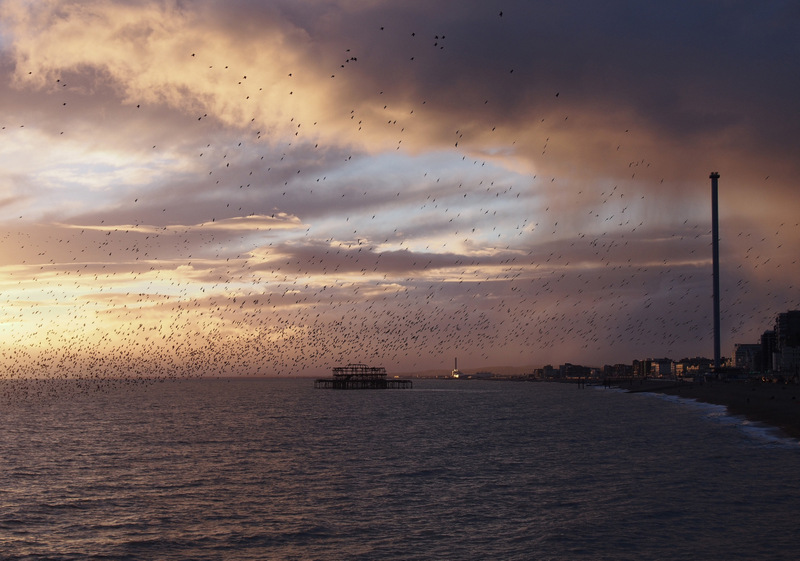

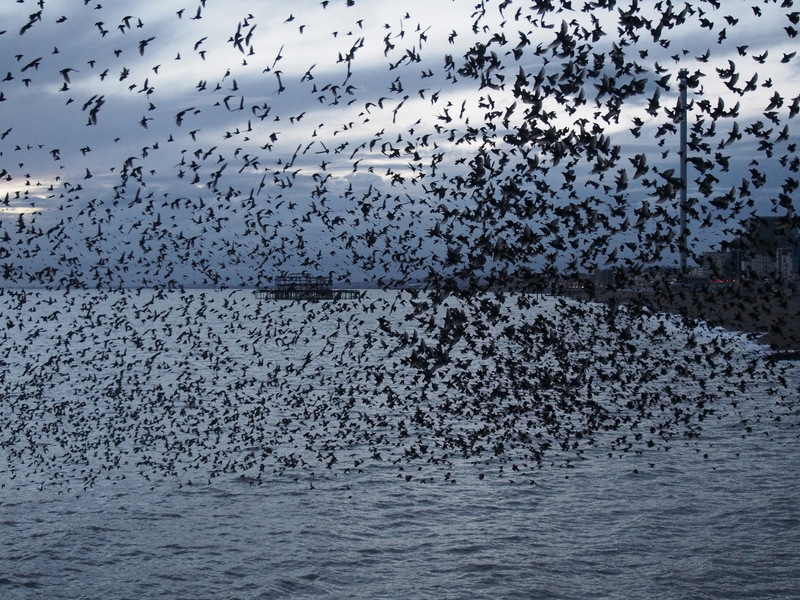
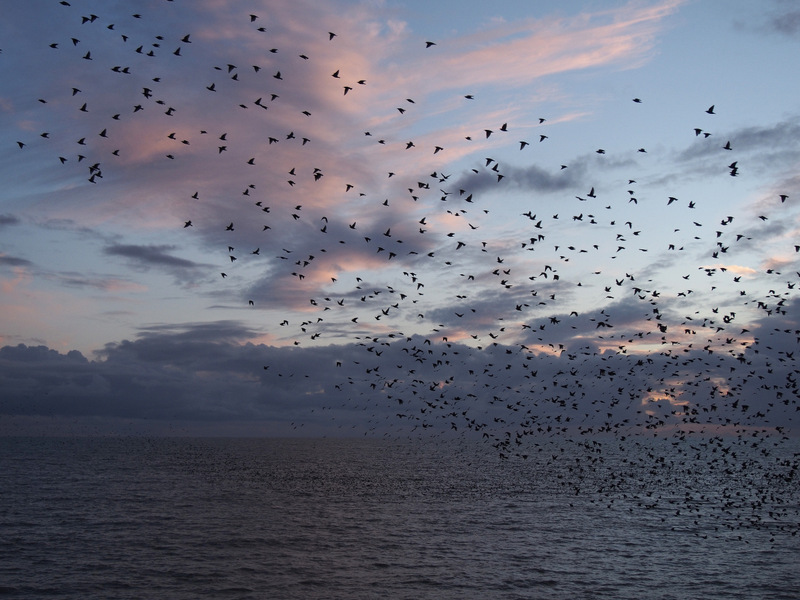
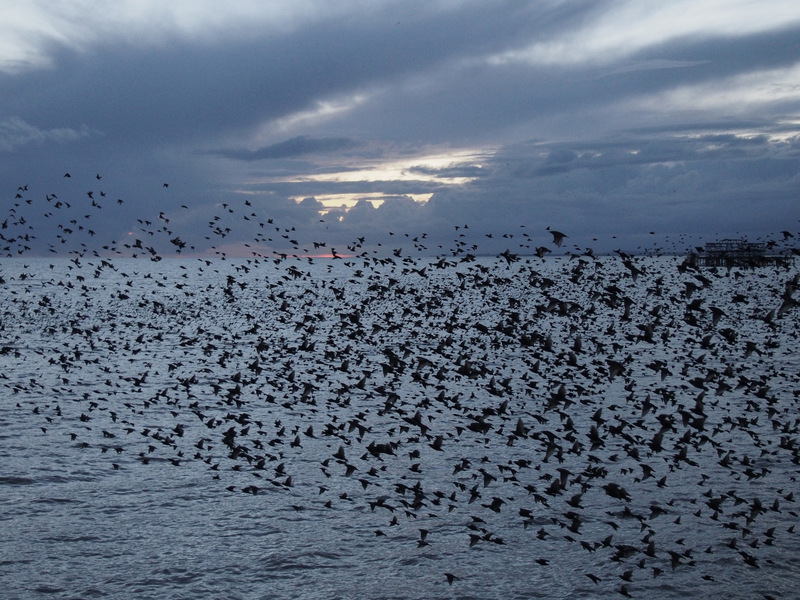
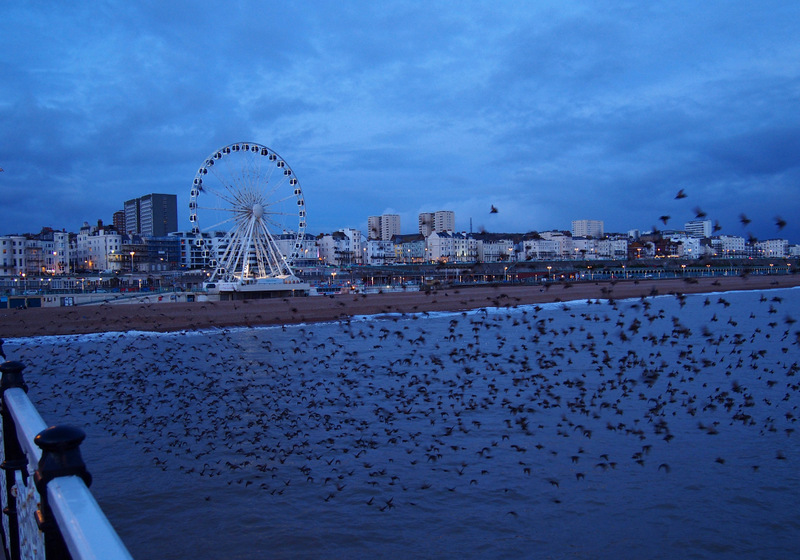
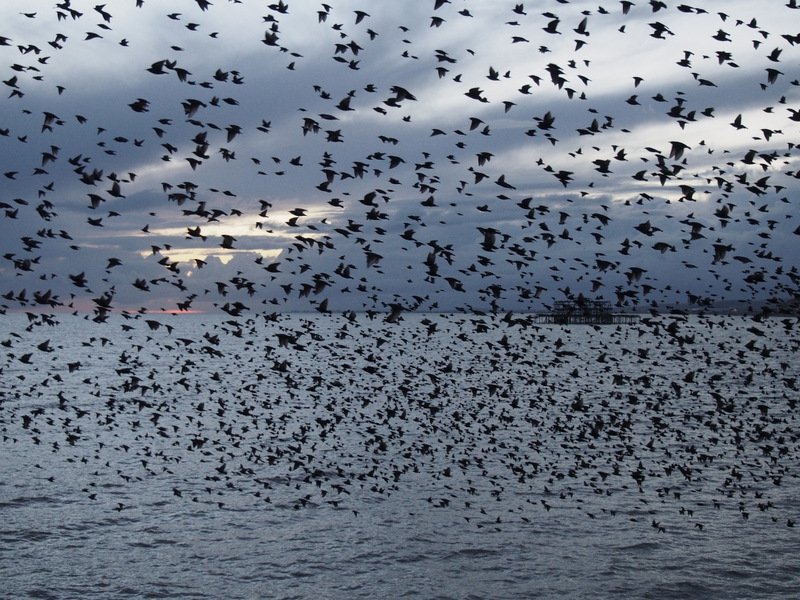
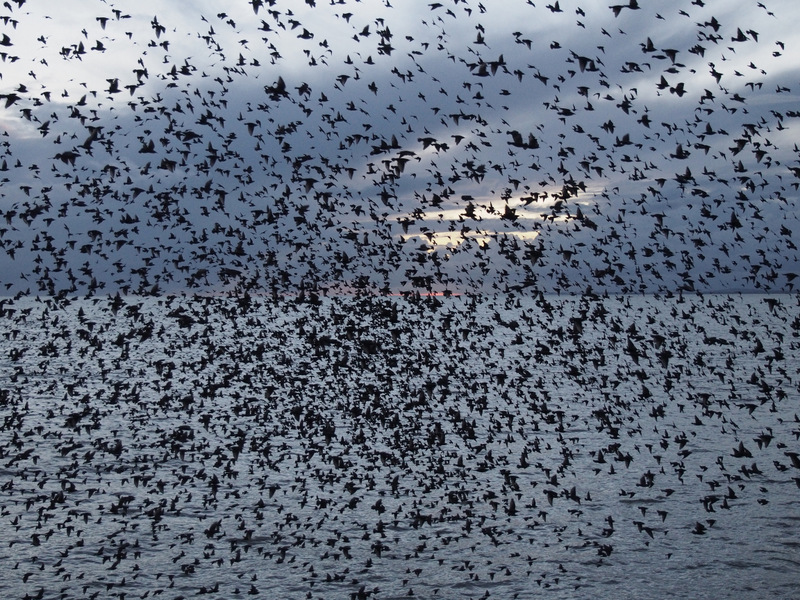






Lovely photos. And what a great quote, “caught with ourselves in the net of life and time.” We indeed have put ourselves in a terrifying position: having created a world in which wild things must depend on us for their survival.
I’ve done some reading on this phenomenon. Murmurating starlings have an estimated reaction time of under 100 milliseconds. In this context, “reaction” is probably not an accurate term, for no one can explain how these birds manage to copy one another with such quicksilver precision. Studies reveal that each bird strives to fly as close to its neighbors as possible, instantly adjusting speed and direction to avoid collision. Tiny deviations in the movements of one bird are felt by those around it, each change causing a ripple effect. This synchronized activity has been compared to “criticality,” the point at which a system, poised on the brink of transformation, becomes something else, as in ice changing to water. In this view, a flock turning in unison can be considered a “phase transition.” The flock is a system, and each bird is inexorably connected to every other bird. How this criticality is created and maintained is a mystery we will not soon be solving.
Thanks ever so much for this wonderful and enriching comment, Jean. The Henry Beston quote, though written some 90 years ago, seems perfectly weighted to describe the condition of human-animal relations today. And the Outermost House, if you’ve never read it, is a tremendous, luminous book.
Like you, my reading around murmurations brought me to this idea of the “phase transition” which you so deftly describe here. One of the things I tried doing on the pier was to focus on a particular bird as they neared, to try and glimpse individuality amidst union, but no sooner had my eyes fastened onto a specific creature it was taken up amidst others, sheering away so swiftly that it blurred within the vast, swirling mass. Those “tiny deviations” you mention are constantly unfolding within a murmuration, so that the ripple effect is continually in play. When it all began, a few minutes after five, it started with a group of twelve starlings fluttering over the pier and water, gradually being joined by other small flocks. And it wasn’t until the congregation had reached several hundred birds that the mystery of the murmuration began to take shape. Until then, their flights had seemed ordinary, the everyday, aerial grace we so often take for granted. But at a particular juncture the assembly gained sufficient voices for it to sing through movement, as though an orchestra reaching its full complement of instruments. All along the pier echoed the breathtaking, heartlifting exclamation of “wow.”
You sing with your words, Julian, and beautifully.
Thanks for your very kind words, Jean. The feeling is mutual :)
Beautiful!
Thank you, Cindy!
Julian, thank you once again for a wonderful post! The photos are lovely. But also thank you for “murmuration” as new word for me – it sounds like a compendium of murmur and admiration, which somehow feels right when viewing a “murmuration”. Also thank you for Henry Beston and his true summing up of the human state – you`ve put me on his track!
Good luck and plenty of fun in the US!
Charles
Many thanks, Charles! I absolutely love your thought of murmuration sounding like a “compendium of murmur and admiration.” That’s easily the best description of these gatherings I’ve heard in a very long time. Do check out Beston – The Outermost House is a glorious book, and still so relevant despite being written in the 1920s.
Thanks for the good wishes and hope all is well with you!
Julian
My pleasure, Julian! I´ve ordered his book – in fact it was the next thing I did after reading your post!!!
Thanks, all is well here!
Cheers
So pleased to hear that! I’m sure you’ll enjoy it very much.
Cheers,
Julian
Thank you for this post! Starling murmurations are not only noisy, they are also smyelly! It’s wonderful really. They smell like warm feathers and poop. :)
Thanks ever so much, Anya! They’re remarkable in so many ways and I’m so pleased you enjoyed the post!
Smelly I meant to say :)
Amazing photos!
Thanks very much!
Amazing, thanks for sharing!
You’re very welcome, Naomi – delighted you enjoyed it!
Marvellous, Julian. The combination of the opening quote with your own reflections produces a gathering of words that really does justice to the spectacle being described. I don’t think I will ever witness a murmuration again without thinking of your ribbons of starlings being spooled into their communal roosts. Thank you for that gift, and all the best for your trip to the USA.
Thanks ever so much for your kind words, Alan. I’m delighted you enjoyed the post. Are there many murmuration sites in Catalonia where you are? That Henry Beston quote has stayed close to me since I first discovered it a few years ago. Although written nearly 90 years ago, it seems apt to our current age and its concerns. Thanks for the good wishes and hope all is well with you!
Good name that…
Starlings strike back, starling nest fires are a big cost to rural insurers here in NZ https://www.youtube.com/watch?v=dO4YAf_W3Z8
Interesting to see about the tractor fires – many thanks!
i like your article, very inspiring and thank you for your post
Thank you very much – that’s very kind of you to say. Delighted you enjoyed it!
Teamwork … something we humans pride ourselves on, but don’t always – or perhaps often – manage!
So very true, Dave. Which is why is seems even more wonderful when we do manage it!
To appreciate it in other species is a start … and helps us to revere nature, not something we often manage either!
Hi Julian,
Excellent footage, stills and writing from your latest visit to Brighton Pier!
I, too,thoroughly enjoy your work and am inspired by it on many levels…. Thank you for all that you share.
Your quote from Henry Beston sent me re-browsing my copy of “Outermost House” – I found myself re-reading passages and appreciating it in a new light, specifically because of your patient manner of observation that you chronicle in “Small Heart of Things.” It’s easy to compare the two books.
Your eloquence and imagery bring me great comfort in sorting out, slowing down and observing through the rather hectic fast-paced life I lead here in Boston, Massachusetts, USA. Journeying through “Small Heart of Things” is a delight – unassuming, poetic, a beauty of an education.
Best wishes and keep up the excellent work. I look forward to more.
Dear Andrew,
Occasionally I read a comment that I find deeply moving on a number of levels, and yours is one of them. Thank you so much for the kind and generous words. ‘The Outermost House’ is a real favourite of mine, so to have my book compared to it is an enormous honour. It’s wonderful to hear how you’ve enjoyed the book, and I really appreciate that you took the time to get in touch and share your thoughts as well. You’ve made the day memorable.
Thanks again and best wishes to you in Boston.
Julian
One day you’ll have a reading in Los Angeles? I would love to listen to you!
So true about people stopping to watch as nature invades and beautifies their worlds before taking leave – at the beach, surfers stopped to watch a gray whale breach and then take deep breaths that burst through the waves they should have been paddling towards.
Despite the seemingly unformed ‘nation’ of birds, there was surely a type of leadership established. Witnessing this, or a chevron of pelicans skimming the ocean…we should be honored.
Thanks once again.